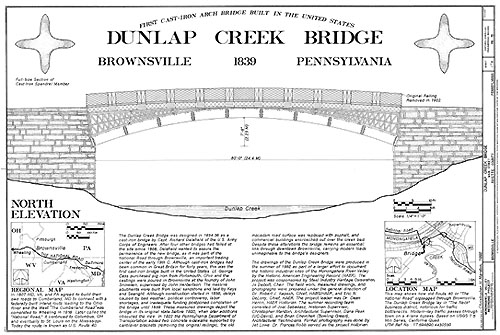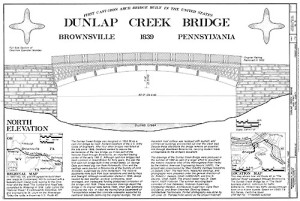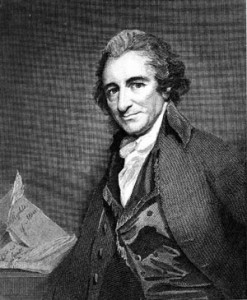Tom Paine’s Bridge

Or, building a better world with iron
Several years ago, while teaching one of those history surveys that gallops across great events as if they were pebbles at Belmont, I asked my students to name a revolutionary. I had in mind Tom Paine—whose Common Sense we had just read—or perhaps Marx. I should not have been surprised by the answer I got: Bill Gates.
A revolutionary? Yes, my students told me. After all, Gates had changed everything. And he did not do this by accident. He even wrote a book, The Road Ahead (New York, 1996), whose first chapter bears the very Trotskyite title “A Revolution Begins.” In that chapter, Gates reflected upon his achievements, the revolutionary looking back on the revolution. What did they know, he and Paul Allen, a couple of school kids tinkering with some funky machine at little old Lakeside School? Well, “We caused a kind of revolution—peaceful, mainly—and now the computer has taken up residence in our offices and in our homes.”
My students agreed. The PC had changed the world. For them, it was clear: things made history. It was a curious, if partly semantic, problem. Would this make Eli Whitney and James Watt more radical than Thomas Jefferson or John Brown?
I had not given the problem much thought until I recently started doing some research on Tom Paine. What drew me to Paine was his peripatetic life. I had finished a project about a traveler who was a contemporary of Paine’s and who led a similarly transatlantic existence. This phenomenon was something I wanted to explore further and Paine seemed the ultimate exemplar of the mobile eighteenth century.
As I started reading Paine, I found myself drawn in an unexpected direction, albeit one that in a weird way validated what those undergrads were telling me some years ago. Paine spent most of the final twenty years of his life pursuing answers to an extraordinary technological problem. The problem was simply this: how do you create a reliable, sturdy, weather-resistant bridge that can span rivers without impeding water traffic? What a mundane problem to occupy the author of The Rights of Man.
And yet the problem was anything but mundane. Paine’s world was a water world. Everything traveled more quickly and more cheaply by water. Where there were no rivers or seas there was little of anything else. What farmers and trappers and miners and other producers could bring to market depended on ready access to water transport. We do not generally think of the Connecticut River or the Schuylkill River or the James River as hugely important commercial arteries. But in the eighteenth century they were. If you stood on their banks in the right season, you would see logs bound together as huge rafts, fifty and sixty foot dugout canoes loaded with deerskins or dried fish, and small sailing craft carrying grain, livestock, or tobacco.
If you lived, say, in the far northwestern corner of Connecticut—hardly a remote place—you may as well have lived in Siberia. (Actually, you might have been better off in Siberia. The Russians had developed an enormous and well-traveled network of post roads—maintained by state-owned serfs—stretching from Lake Baikal in Siberia to St. Petersburg. Interestingly, these were more efficient arteries during the long winters when horse pulled sledges could glide across what would otherwise be wet, boggy terrain.). Getting anything to market—you would probably head to the river town of Hartford—would have involved a treacherous journey across barely maintained trails, usually unable to accommodate any kind of cart or carriage and all but impassible in the winter months. If, heaven forbid, you should stumble upon the swollen Housatonic or Farmington Rivers, you would hope to find a ferryman nearby and you would hope he knew and liked you and was happy to take a few pounds of grain or a few deer skins for his services. You would also hope the weather cooperated. Storms and spring ice made river crossings a deadly business.
Imagine a world without these problems. Imagine simply being able to carry your goods across a bridge. Sure, you might have to pay a toll, but you could travel when you wished, unimpeded by the comings and goings of ferrymen and foul weather. And you could expect, with a nice bridge across the Housatonic for instance, that others would be following you to market, perhaps now carrying large loads of corn and rye. And with those others now happily farming in northwest Connecticut, more people would be more dependent on roads and thus more inclined to band together to maintain them. Above all, if you could make rivers easy to cross you could open once remote tracts to European-style farming and if you could do that you could, in theory anyway, make more land available to more people. You could, to put it simply, help the cause of liberty.
This would all have been very agreeable to Tom Paine. He believed in property and he believed in the “projecting spirit,” that spirit of invention that seemed to inhere in the breasts of all men (this was, as far as I know, understood to be a distinctly masculine quality). He thus advocated the creation of a national system of copyright so that authors could, in effect, claim proprietary interests in their work. Not only would this afford fair remuneration, it would also—so Paine believed—spur creativity. Why create if you cannot serve yourself in the process?
Bridge technology was obviously not a new thing in Tom Paine’s America. The Romans had created great stone ones and Europeans continued to build stone bridges using what was basically a modified Roman design. In the new United States, small wooden bridges were most common. They required little specialized knowledge and far less labor than stone bridges. But above all, wood was far more abundant in North America than in Europe.
Wooden bridges had a number of problems though. One was simply that they decayed. Moisture softens all but the rarest hardwoods, exposing load-bearing timbers to wood-boring organisms that can, in a matter of months, turn them into sawdust. The problem is especially acute on the flat road surface where pounding wagon wheels and horse hooves combine with accumulated rainwater, snow, or ice to speed decay. By the early nineteenth century, American bridge builders had devised a solution to this problem in the form of the covered bridge, but other problems with wood remained.
One was that building a wooden bridge long enough to span more than ten or fifteen feet was extremely difficult. With a growing scarcity of long, hard timbers, bridge builders had to rely on supporting piers. Aside from inhibiting river traffic, these were extremely difficult to build. They usually required temporary parapets, built midriver, within which stone foundations could be constructed. But even the most robust piers were vulnerable to forceful flood waters and spring ice.
Paine was among a small group of tinkerers who recognized that the solution to these problems lay in an old material put to a new use. That material was, of course, iron. In the short term, iron lost no strength when wet, and it could be easily fashioned into light, readily transported arches, western architecture’s strongest element. The strength of the arch allowed bridge builders to span waterways without costly piers that inhibited river traffic. But above all, Paine and his fellow inventors saw few limits to the potential span of iron bridges. As long as the basic design was sound, the scale was limited only by the ironworkers’ capacity to fashion the arches.
The material’s first real trial came in 1779 when an ironmaster named Abraham Darby III completed the world’s first iron bridge over the Severn River Gorge near the town of Coalbrookdale in England. It was a spectacular achievement. The one hundred-foot arch eased the movement of labor, manufactured goods, and raw materials fueling the region’s booming industrial economy.
Great though the Coalbrookdale Bridge was, Paine recognized several drawbacks. The first was that it was made from a vast, semicircular arch, whose height made the design feasible only for rivers running through deep gorges—or for bridges with costly embankment towers. And second, it remained largely the work of a single, creative mind. There were no plans or instructions on how similar structures might be erected elsewhere. If more such bridges were to be built, they would have to be built by Darby. This is one reason it took a decade and a half for Britain’s next full-scale iron bridge to appear.
Paine’s ambition was to solve both of these problems. He believed the same basic design principles could be applied to a much shallower arch, fashioned from a “small segment of a large circle.” Such a shallow arch could span more than a hundred feet and required no more than five feet of vertical clearance. An arch was an arch. The same principles that applied to large segments of smaller circles applied to smaller segments of giant circles.
But perhaps even more innovative was Paine’s approach to the design and construction process. Instead of crafting a bridge in the way a joiner might a house or a wheelwright a wagon wheel—relying on experience and individual knowledge passed from one craftsperson to the next—he would begin with a design. And that design would be carefully tested, codified, and disseminated. Though he was a great advocate of individual patents, he would not seek one for his iron bridge. It was to become part of the public domain, accessible to all much like the uncannily crisp prose of his most famous pamphlet, Common Sense.
It was all very democratic and very much contrary to the closed and carefully guarded practices of the artisans and trade guilds in which Paine had once found his most loyal political constituency.
This story, like much else in Paine’s life, ends in failure. Paine’s design never made it beyond a prototype exhibited near London. Paine eventually tried to persuade the American Congress to invest in an ambitious version, but to no avail. Nobody in the new American polity—an increasingly Christian polity—wanted to pay the price of associating with such an unapologetic skeptic. It would not be for another thirty years, long after Paine’s passing, that an actual iron bridge would be built in the United States.
Paine blamed the initial collapse of the project on the French Revolution. It was that event that prompted his former friend, Edmund Burke, to publish a popular defense of hereditary rule. The greatest political pamphleteer of the time could not sit idly by. He abandoned the iron bridge project to compose The Rights of Man, a searing rejoinder to Burke. “The publication of this work of Mr. Burke,” he later wrote, “drew me from my bridge operations, and my time became employed in defending a system [of representative government] then established and operating in America and which I wished to see peaceably adopted in Europe.”
We do not often think of Paine as a revolutionary inventor. But in a very real sense, that is what he believed himself to be. Paine saw in bridge design a handmaiden of social and political change. In encouraging freedom of movement, bridges could free individuals to better themselves. They could free farmers and merchants and craftspeople to move freely through the countryside, and in doing this, they could free them to prosper and become true citizens with a vested interest in the political nation.
Further Reading:
Paine discussed his iron bridge activities in several letters but he said most about the project in his 1803 petition to Congress, reprinted in Eric Foner, ed., Paine: Collected Writings (New York, 1995). Paine’s remarks on copyright appear in a 1782 letter to the Abbé Raynal, reprinted in volume 2 of Philip S. Foner, ed. The Complete Writings of Thomas Paine (New York, 1945). The most recent and most complete treatment of Paine and his iron bridge appears in chapter 9 of John Keane’s Tom Paine: A Political Life (New York, 1995).
This article originally appeared in issue 5.4 (July, 2005).
Edward Gray is the Editor of Common-place and associate professor of history at Florida State University.

